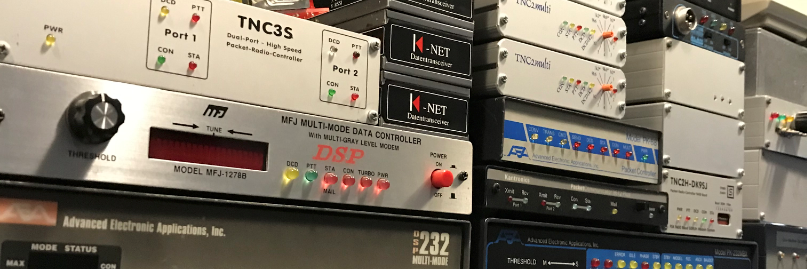Charles N2NOV has written a fantastic document with a clear explanation about netrom quality`s and parameters.
- NetRom Protocol
- NetRom Tutorial By Charles N2NOV
- Netrom Quality`s By John G8BPQ
- Netrom Quality`s By Brian N1URO
Setting NetRom Parameters I was looking at the old NEDA (NorthEast Digital Association) newsletters from twenty years ago (1999) and want to show you some pertinent NetRom parameters that might help with the bloated (some up to 800) nodes lists that we see from time to time. These started as X1J parameters, but you might find them useful to give you an idea how to tweak your BPQ, Xrouter, *NOS, Flex, etc systems. Each program might use a different naming convention, but reading the details of your documentation will align to NEDA labels. As always, adjustments can be made for a non-standard configurations like full duplex data repeaters, etc. Feel free to discuss the technical points here, but gear the explanation for the newer sysops. The parameters are broken down differently by the type of connection you have with another station (mostly RF-based). Adaption to an AXIP link via wired internet should follow the Dedicated Point-to-Point Link (DPPL). USER PORT (typical 2 meter port): No node table is broadcast to keep the channel clear. Do this by setting Initial (Default) Obsolescence at 5 and the Minimum Obsolescence to 6. Since the default is lower than the cutoff, it will never broadcast. DPPL (only two backbone users on a dedicated frequency) [or AXIP]: Your partner station should be a locked route with quality of 203. Accept incoming nodes from your partner with minimum quality of 63. Initial (Default) Obsolescence at Minimum Obsolescence to 3 Nodes Broadcast Interval 900 seconds (15 minutes) The obsolescence count will start at 5 and decrement by 1 every 15 minute cycle and stop when it hits 3 if there is no refresh from your partner station. This keeps things clean and updated within 30 minutes. Multiway Backbone with 3 Partners (typically 220 Mhz regional channel): Your partner station should be a locked route with quality of 203. Accept incoming nodes from your partner with minimum quality of 63. Initial (Default) Obsolescence at 5 Minimum Obsolescence to 2 Nodes Broadcast Interval 900 seconds (15 minutes) The obsolescence count will start at 5 and decrement by 1 every 15 minute cycle and stop when it hits 2 if there is no refresh from your partner station. This keeps things clean and updated within 45 minutes. This allows for occasional transmitter collisions between partners. NOTE: current practice is to set minimum quality values at 150 or 180 is only to mitigate the effect of mislabeled nodes qualities broadcast to partner systems that get propagated. There are several systems that make all of the nodes in their table higher than they should be. When the network is cleaned out and realigned, then the minimum quality can be adjusted downward. How are node qualities adjusted when the nodes table is passed around the network from partner to partner? *** ONLY WHAT IS ON YOUR PHYSICAL BOX OR WIRED LAN SHOULD BE HIGHER THAN 203 *** Initial partner default quality is 203 (out of 256) or 203/256 First hop between AXIP partners is 203/256 * 203/256 or 161/256 Second hop between AXIP partners is 161/256 * 203/256 or 128/256 Third hop between AXIP partners is 128/256 * 203/256 or 101/256 Fourth hop between AXIP partners is 101/256 * 203/256 or 80/256 Fifth hop between AXIP partners is 80/256 * 203/256 or 63/256 Let's look at how various stations relate to each other on the NetRom nodes list. First, each station sets their partners at a default value of 203 if on AXIP or DPPL. This is only the value between the two stations talking to each other. Here are some of my forwarding partners and some of their other partners.

Second, let's look at how those next-line stations actually calculate to my station. If my partner is 203/256 (or about 80% reliability) and so is their partner, then the second-level station is not going to be 80% reliability to me. BBGATE:AA6HF-4 is 80% to me on a direct connection, but has to be less when going through LAXNET:N6ROE-3.

By doing the calculation of each level's reliability of 203/256 against the next level, we get 203/256 x 203/256 (same as 0.79296875 x 0.79296875) or 161/256 (0.628799438476).

If we extend this exercise by multiplying against the next level of 203/256 we get:

Going down level by level we get values of 128 (X), 101 (Y), 80 (Z), etc. By setting MIN QUALITY you can cut off how many levels (hops) you want to see. MIN QUAL 161 lets me see all stations closer to me above the level that X is on. MIN QUAL 128 allows me to see down to the level of X. MIN QUAL 101 allows me to see down to the level of Y. MIN QUAL 80 allows me to see down to the level of Z.
